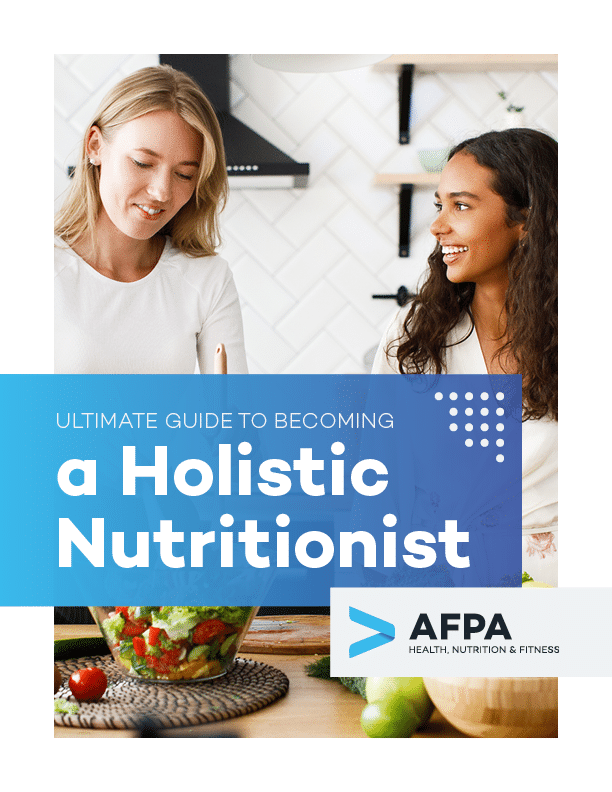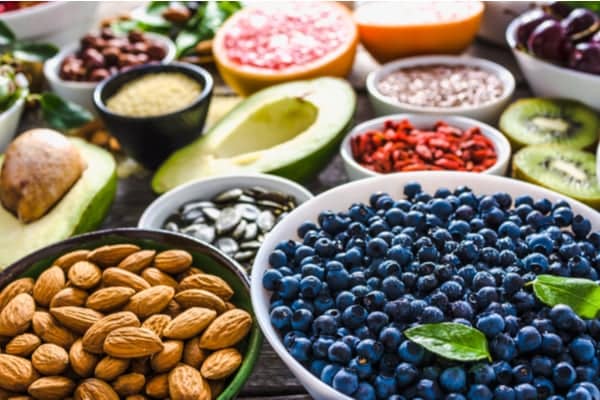Humans, like all living things, need to consume food to live. The biological, psychological, and sociocultural need to eat, in fact, is one of the experiences that unite all people.
Whole food is what humans see and react to, but it is the nutrients in food that our cells utilize to carry out their functions. Too much or too little of the nutrients humans require over long periods of time can lead to a deterioration of cell function, eventually leading to malfunction and, potentially, chronic disease.
What does nutrient balance look like? This article explores the tools you have at your disposal to gauge nutrient balance and healthy nutrition for disease prevention. It also describes how both nutrient excess and nutrient deprivation (undernutrition) influence the risk of chronic disease.
Nutrient Balance for Health and Chronic Disease Prevention
Our bodies require a wide range of nutrients to carry out daily activities. For the purpose of understanding what it is in food that meets our needs, nutrition scientists identified numerous nutrients and studied their specific roles in the body.
These nutrients include:
- Macronutrients: Elements that provide energy. They include carbohydrates, fats, and protein. Carbohydrates and protein contribute 4 kilocalories (a measure of energy) per gram, and fats provide 9 kilocalories per gram. Alcohol also provides energy at 7 kilocalories per gram, but it doesn’t have a function in the body, so it isn’t considered a nutrient.
- Micronutrients: Chemical substances or elements that are required in small amounts in the body for the body’s growth, development, renewal, and function. They include vitamins and minerals, as well as phytonutrients like antioxidants.
- Water: Water is often left out of the equation, but it is considered an essential nutrient because the body cannot produce water. The human body is made up of 60-70% water. It fills up space between cells, forming part of molecular structures of essential nutrients. While we tend to think of water in its pure form, water is found in some quantities in most foods, especially fruits and vegetables.
A lack of balance of nutrient intake is referred to as malnutrition (poor nutrition). Keep in mind, however, that, with a few exceptions (like trans fat), there aren’t “good” or “bad” nutrients. We need all nutrients in different quantities, and what we need changes throughout our lives and as our lifestyle and health status change.
Daily Value, Recommended Dietary Allowance, and MyPlate — Which Is Best to Gauge Nutrient Balance?
In the interest of health, nutrition scientists study the role of nutrients in the body and estimate how much of these nutrients a human needs to maintain normal function. Then, scientists and public health workers come together, examine the evidence, and come up with recommendations for nutrient intake for the general population to stay healthy.
The two most common terms used to describe these estimates are the Percent Daily Value (%DV) and the Recommended Dietary Allowance (RDA). RDAs tell you, on average, how much of each nutrient you should be getting every day. In the US, these are established by the Food and Nutrition Board at the Institute of Medicine of the National Academies. RDAs vary based on sex, age, and whether a woman is pregnant or breastfeeding.
In general, RDAs are helpful for the general population; people will not likely memorize the RDAs for each nutrient, and, unless you use an app, it would be near impossible to keep track of how much of each nutrient you’ve consumed throughout the day. Additionally, it’s not a “magic number” people need to hit daily—it’s an estimate of the average amount of that nutrient people need, meaning that some days you may consume less, others more, and you will still have nutrient balance.
Percent Daily Value (%DV or DV) is established by the Food and Drug Administration, and it is used on food and supplement labels. Unlike RDAs, DVs do not differentiate between sex, age, or whether a person is pregnant or breastfeeding. There is one DV for each nutrient for all people over the age of four, meaning that it is an amalgamation of estimated nutrient needs for all people. DVs suggest how much of each nutrient a person is consuming in one serving of food.
Though imperfect, RDAs are useful tools for clinical specialists and public health workers who develop food guidelines. DVs are useful to inform people on what nutrients are consumed through food.
It is important to note, however, that not only is keeping track of RDAs or DV throughout the day difficult, allowing your eating habits to be dictated by measuring RDAs or other measures can lead to disordered eating.
Additionally, neither DVs nor RDAs are the best tools for the general population to understand what they should be eating to achieve a balanced diet. Tools like the MyPlate in the US, while also imperfect, tend to be much more practical choices to help people make healthy decisions on a daily basis. Other approaches outside of the public health strategy, like Intuitive eating, for example, can support people in listening to their body’s nutrient needs and eating accordingly without obsessing over specific food groups or nutrients.

Get Your Free Guide to Becoming a Holistic Nutritionist
Learn about the important role of holistic nutritionists, what it takes to be successful as one, and how to build a lucrative, impactful career in nutrition.
Nutrient Overload and Its Role in Chronic Disease Promotion
Health practitioners often refer to nutrient excess as overnutrition. However, since overnutrition is often defined as an excess in the consumption of macronutrients that lead to the accumulation of body fat, some health professionals prefer the term nutrient overload or chronic nutrition overtake since an excess of the intake of micronutrients can also lead to the development of chronic disease, even when weight change is not implicated.
The human body is built with natural mechanisms that help to buffer changes and fluctuations in nutrient intake and other factors that affect nutrient requirements, like short-term illnesses and increased physical activity. However, if the nutrient overload is continued over significant periods of time (from weeks to years, depending on the period in a person’s development and the severity of the overload), it can result in irreversible damage to cells. According to Qiu and Schlegel in Nutrition Reviews, “Under the chronic food intake, both organelles experience stress, burdened by metabolite saturation, and eventually, long-term damages result in reduced efficiency.”
Most research on nutrient overload has focused on macronutrients—fats, proteins, and carbohydrates—because of their effects on insulin release and related cell signals. Researchers know, for example, that excess consumption of saturated fats and simple carbohydrates over long periods of time increases the risk of developing metabolic syndrome and type 2 diabetes.
Other chronic conditions associated with excessive insulin secretion related to nutrient overload together with a biological and genetic predisposition are:
- Non-alcoholic fatty liver disease (NAFLD)
- Polycystic ovary syndrome (PCOS)
- Atherosclerotic cardiovascular disease (ASCVD)
However, the excess of certain micronutrients can also lead to an increase in the risk of chronic disease. Here are some examples:
- An excess of iron intake can lead to a higher risk of type 2 diabetes.
- An excess of phosphorus intake is a risk factor for chronic bone, kidney, and cardiovascular diseases.
- An excess of folic acid intake has been demonstrated to moderately increase the risk of developing prostate cancer.
Nutrient Deprivation (Undernutrition) and Its Role in Chronic Disease Promotion
Undernutrition is defined as the chronically insufficient intake of energy and nutrients to meet an individual’s needs to maintain good health. While there are specific terms to describe types of undernutrition, like protein-energy malnutrition or micronutrient deficiencies, several health institutions encourage the use of the term undernutrition since it encompasses all types of undernutrition.
Our body cannot make most of the nutrients it requires to carry out regular functions; it needs to obtain those nutrients from foods. Similar to what happens with nutrient overload, our bodies can buffer deficiencies in the short term. However, if we are deficient in macronutrients or micronutrients for a significant period of time, healthy body development, repair, and growth can all be put at risk.
The amount of time that bodies can continue to function healthily with nutrient deprivation depends on the specific nutrient, age, stores, genetics, diseases, and other factors.
For example, vitamin A deficiency is more severe in childhood than in adulthood. In childhood, vitamin A deficiency can lead to night blindness, growth retardation, and infections; in fact, vitamin A deficiency has a very high mortality rate. In adults, vitamin A deficiency can lead to impaired immune health and skin pigmentation problems. But it has a much lower mortality rate.
Undernutrition in childhood, and even before birth, can have life-long effects. Fetal undernutrition due to maternal undernutrition can lead to what is often referred to as fetal programming for adult chronic disease. Additionally, childhood adverse events associated with food deprivation not only increase the risk of developing chronic diseases due to undernutrition but also due to the effects of toxic stress on the body.
Some of the chronic diseases linked to undernutrition include:
- Chronic kidney disease
- Cardiovascular disease
- Cancer
- Metabolic syndrome and diabetes
- Chronic pancreatitis
- Inflammatory bowel disease
- Obstructive pulmonary disease
- Hepatic encephalopathy
Applying This Knowledge in the Coaching Environment
It is important to understand that nutrient overload with a wide variety of nutrients may increase the risk of developing chronic disease. However, on individual levels, this knowledge can be difficult to apply.
Health and wellness coaches and other health professionals can use the knowledge about the risks of nutrient excess to:
- Evaluate the need for supplements carefully.
- Support clients and patients in making food choices and gaining access to foods that lead to balanced and satisfying nutrition without obsessing over excess since this can lead to disordered eating.
- Support clients in finding ways to move their bodies that they feel comfortable with.
- Avoid shaming clients about their food choices, and instead, learn about the barriers that may prevent them from eating a balanced diet.
- Support community programs that help to improve the variety of culturally appropriate, appetizing, and low-cost foods.
Main Takeaways
Diet is a cornerstone of health. We obtain the nutrients our bodies need to survive, function, grow, and thrive through the foods we eat and beverages we drink. Both nutrient overload (too much of some nutrients) and nutrient deprivation (too little of certain nutrients) can lead to irreversible damage to our health in the long term, and they may increase the risk of developing chronic diseases.
From the perspective of a health coach, learning about nutrient balance can help to inform and guide clients. For clients and individuals, however, it is often more beneficial to focus on the whole diet together with wellness as a whole rather than focus on specific nutrients.

Become an Expert Nutrition Coach at Your Own Pace
Download your free guide now.
References
- https://doi.org/10.1016/j.clnu.2013.09.006.
- https://doi.org/10.3390/nu11020459
- https://www.who.int/news-room/q-a-detail/malnutrition.
- http://www2.ca.uky.edu/agcomm/pubs/FCS3/FCS3563/FCS3563.pdf
- https://www.ncbi.nlm.nih.gov/books/NBK234926/
- https://onlinelibrary.wiley.com/doi/abs/10.1002/eat.22966.
- https://www.myplate.gov/
- https://doi.org/10.4103/ijmr.IJMR_1703_18
- https://academic.oup.com/nutritionreviews/pages/chronic_nutrition_overtake_can_lead_to_the_onset_of_multiple_diseases
- https://journals.sagepub.com/doi/full/10.1177/1479164119827611
- https://doi.org/10.1186/1741-7015-10-119
- https://doi.org/10.3945/an.113.004234
- https://www.ncbi.nlm.nih.gov/pmc/articles/PMC3345626/
- https://www.msdmanuals.com/professional/nutritional-disorders/vitamin-deficiency-dependency-and-toxicity/vitamin-a-deficiency
- https://doi.org/10.1016/j.puhe.2011.11.014.
- https://www.cabdirect.org/cabdirect/abstract/20043196732.
- https://doi.org/10.1186/s12882-019-1530-



